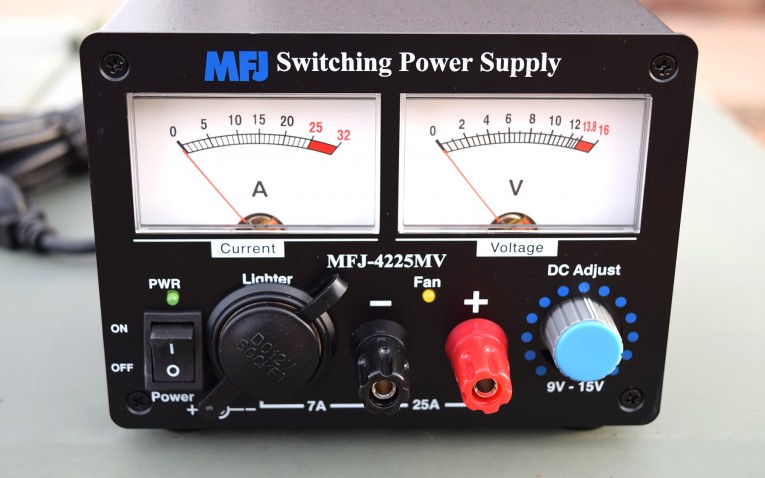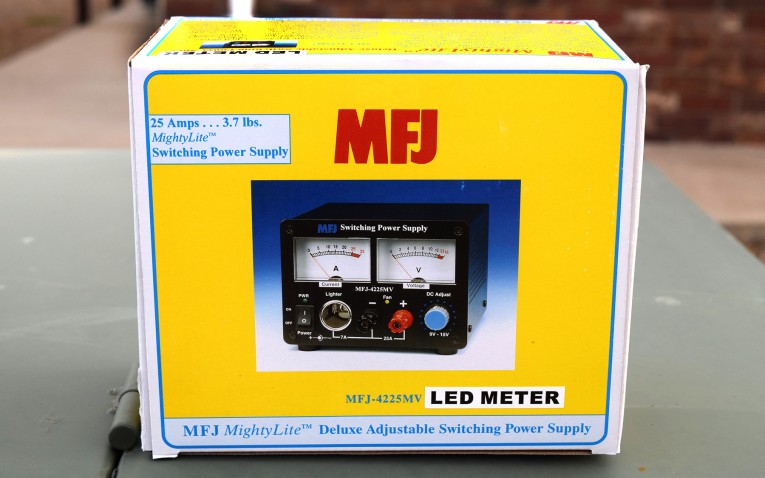The MFJ-4225MV is the ‘newest’ DC power supply offered by MFJ. Coming in at more than a dozen years old, it isn’t really new, but it has some features that give it a modern, sleek appearance. It’s rated for 25 amps surge or 23 amps continuous at 13.8 VDC and is adjustable from 9-15 VDC, which means that, from a power point of view, it’s perfectly capable of running most HF or VHF/UHF transceivers you send its way. As you’ll read below, I think the MFJ-4225MV has some serious design flaws that really should be addressed, especially considering how established the company is. Nonetheless, I own one and I’m generally pleased with it.
So let’s check this thing out.
From the Outside to the Inside
The size and weight of the MFJ-4225MV’s box was surprising to me–it is rather small and light. The packing is old school–reds, yellows, and blues that look straight out of the 70’s. I’ve got to say, poor packaging really bothers me. It’s not that MFJ’s packing is terrible, it’s just that they haven’t done anything to update it and keep it modern-looking. As a younger ham who cares a great deal about amateur radio’s future, I really want to see manufactures market their products toward an increasingly younger demographic. It makes the industry easier for young people to get interested in when the aesthetics are ‘familiar’.
Ok, back to the product. As I said, it’s light and it’s small (only 4.2 lbs!) Everything seems very solid and high-quality when taken out of the package. The feet are quite sturdy, and the casing just feels ‘right’. The sides have a generous amount of ventilation holes, which are no doubt a good thing. (Although with how loud the fan is, the holes may be redundant! More on that later.) Finally, the back panel has a small, recessed slider located below the power cord to switch between 110 and 220 volt inputs.
The front panel is attractive and well-labeled. The ‘Current’ and ‘Voltage’ meters are both beautifully lit with white LEDs, which provide even light over the whole display. Obviously LEDs are not very expensive, but it’s one of those little things that makes a product ‘pop’, especially in the MFJ-4225MV. Below the metered displays are two more ‘status’ LED’s–one for ‘PWR’ (right above the power switch) and one for ‘Fan’. The two DC power output options are a 7 amp ‘lighter’ socket and a pair of 25 amp Five-Way Binding Posts. The 7 amp socket is geared more for accessories, but is perfectly adequate for most handhelds/HT’s, supposing you have a battery eliminator. For everything else you’ll use the Five-Way Binding Posts (HF/VHF/UHF.)
The last thing to discuss regarding the casing and user interface is the ‘DC Adjust’ knob. Now, it feels smooth enough when adjusting it, but the first thing I noticed is that the ‘notch’–the little ‘click’ you would normally expect to be located right in the middle, at the top–is actually about 5 degrees to the right of center. At first this confused me, and I assumed it was a small production defect. Well, apparently the ‘center notch’ is supposed to have a small offset, and it’s made to coincide with 13.8 VDC, which is what most radio applications require. The reason I didn’t notice this is because when I set the knob to its natural ‘notch’, the voltmeter doesn’t actually display 13.8 volts–it’s really closer to 12.5 VDC. It’s not a huge deal, and I can easily just turn the nob up until the meter reads 13.8, but it’s one of those things where you would think MFJ might have fixed this by now.
Operations
Let’s turn it on.
MFJ-4225MV
Powering up and adjusting the voltage of the MFJ-4225MV
As you can hear, it’s rather noisy. I will say, it’s not an ‘abrasive’ sound, but it is very much present. It’s a very smooth ‘whirl’ that fades into the background while actually operating the radio. Even though there is a yellow LED on the front labeled ‘Fan’, the fan runs allthe time. I’ve never had it shut off, even when the power supply is just being run passively. What MFJ shouldhave done is add a fan switch somewhere on the front so that users could turn the fan from ‘OFF’ to ‘AUTO’. I understand there is a bit of a safety hazard with the supply being on without a fan, but with how ventilated this device is, it really doesn’t need to run a fan all the time. (There are several examples online of folks rigging these with aftermarket switches–give them a look-see if you’re interested.)
Notice on the video where the needle rests when I’ve got the dial turned to ‘midpoint’–it’s well below 13.8 VDC. Again, as long as I can set it at 13.8 VDC I’m good to go (that’s the only setting I personally use), but I think they could do a better job of this when making the product.
As for the lights, they provide an even, white glow which is pretty nice in a darker room.
The Bottom Line
Even with it’s flaws, the MFJ-4225MV is reliable, lightweight, and attractive. For those reasons alone I think it’s a keeper (like I said, Iown one!) If you’ve got some interesting experiences with this little guy, please comment below! I’d love to here your story.
If you happen to be interested in buying an MFJ Mightylite, take a moment to consider purchasing through the MFJ-4225MV‘s product link here. At no extra cost to you, a small portion of the price will come my way, and will help support my family and the development of ARTech! Thanks!






